
POR Registration Number: POR 013-14
PWGSC Contract number: 59017-140077/001/CY
Contract award date: 2014-06-26
Delivery date: 2015-02-15
Prepared for the:
Office of the Superintendent of Financial Institutions (OSFI)
Ce rapport est aussi disponible en français.
For more information on this report, please e-mail:
information@osfi-bsif.gc.ca
Prepared by:
Environics Research Group
336 MacLaren Street
Ottawa, ON K2P 0M6
www.environics.ca
The Office of the Superintendent of Financial Institutions (OSFI) is the primary regulator of federally regulated financial institutions and federally administered pension plans. To help assess how well it is achieving its mandate, OSFI undertakes consultations with senior executives within the financial community for their perceptions of OSFI's performance.
A key element of OSFI's stakeholder consultations program is a biennial survey of CEOs of all federally regulated financial institutions, including banks and other deposit-taking institutions, and life and property and casualty insurance companies.
The research objective of the 2014-15 Financial Institutions Survey (FIS) is to provide a high level assessment of OSFI's overall performance on a series of core measures, including:
Where relevant, the 2014-15 results are compared to the three previous research waves to understand how perceptions of OSFI's performance have changed over time.
This report presents a detailed analysis of the study results, with comparisons to previous waves of the FIS where applicable.
A set of tabulated data tables is provided presenting the results of each question in the survey for all participants.
Unless otherwise noted, all results are expressed as a percentage. Charts and tables may not add to 100% due to rounding or multiple mentions. Results for most questions have been recalculated to exclude the small number of respondents who answered "don't know" or who did not offer a response.
The results are based on an online survey conducted with 106 senior executives of federally regulated financial institutions, between September 23 and October 22, 2014.
Since the approach was an attempted census (i.e., entire population of active financial institutions regulated by OSFI was invited to participate in this study), there is no margin of sampling error to be estimated or reported. The moderately good response rate and the similarity of responding institutions to the entire population on key characteristics (industry sector, asset size) indicates that the results are likely to be representative of financial institutions regulated by OSFI.
A list of active financial institutions (246) was provided by OSFI to Environics, all of whom were invited to participate in this research. These institutions comprise all active deposit-taking institutions and insurance companies supervised by OSFI meaning that the survey represents an attempted census of these financial institutions. As with previous iterations of this survey, financial institutions in windup were not included as the questions would not be relevant. The data presented in this report is unweighted.
Almost all responses to the survey (103) were completed by small and mid-sized institutions. For the purposes of this study, small and mid-sized institutions are defined as all financial institutions excluding Canada's six largest banks and three largest life insurance companies.
The following table profiles the number of completed surveys within each subgroup and how this compares to the entire population of financial institutions regulated by OSFI. The final sample is largely consistent with the population by industry sector and asset size, and can therefore be considered representative of the population according to these known characteristics.

The questionnaire was based upon the 2012-13 survey, but was updated to ensure the content is relevant to current issues of interest to OSFI. In particular, a new set of questions was added specifically directed to small and mid-sized institutions. Also, several new open-ended questions were added to allow financial institutions to provide feedback in their own words. Once the English version was approved by OSFI, the questionnaire changes were translated into French by OSFI.
Prior to finalizing the survey for field, Environics conducted a full pre-test with "live" respondents, in both English and French. This consisted of an online survey in the same manner as for the full survey, but with a small number of respondents and with the inclusion of a small set of pre-test questions. The results of the pre-test interviews were reviewed by Environics' senior research consultant and representatives from OSFI. Only one small text change was made to the questionnaire following the pre-test. Copies of the final versions of the questionnaire are included in the Appendix.
The online survey was conducted according to the following steps:
All research instruments are included in the Appendices.
All surveys were conducted in the respondent's official language of choice. Two surveys were completed in French; the remainder were completed in English.
All research work was conducted in accordance with the professional standards established by MRIA, as well as applicable federal legislation (Personal Information Protection and Electronic Documents Act, or PIPEDA). The survey was registered under the MRIA's Research Registration System, which permits the public to verify a survey call, inform themselves about the industry and/or register a complaint.
The response rate for the survey is 43%. This is calculated as the number of responding participants (106), divided by the total eligible sample (246).
This is a good response rate for a survey with busy senior executives, but is lower than achieved in previous FIS surveys (e.g., the response rate for the 2012-13 online survey was 68%). Since the methodology is consistent with the previous research waves, it is unclear why the response rate has declined. A hypothesis is that the timing of the research may have coincided with the year-end of some financial institutions, affecting their capacity to participate during this busy period.
↑indicates a significantly greater proportion than the prior FIS results
↓indicates a significantly lower proportion than the prior FIS results
Differences in comparison to the prior FIS results are indicated if they are statistically significant (at the 95% confidence level).
○ indicates a significantly greater proportion than the comparison group
□ indicates a significantly lower proportion than the comparison group
Differences between DTIs and insurance companies are indicated if they are statistically significant (at the 95% confidence level).
The vast majority (86%) are satisfied with OSFI as the regulator and supervisor of Canada's financial institutions. While the change in the proportion who are "very satisfied" (43%, down from 49% 2012-2013) with OSFI is not statistically significant between 2012-13 and 2014-15, it does continue the downward trend since 2010-11.
Graph 1: Overall Satisfaction with OSFI (total sample) over time
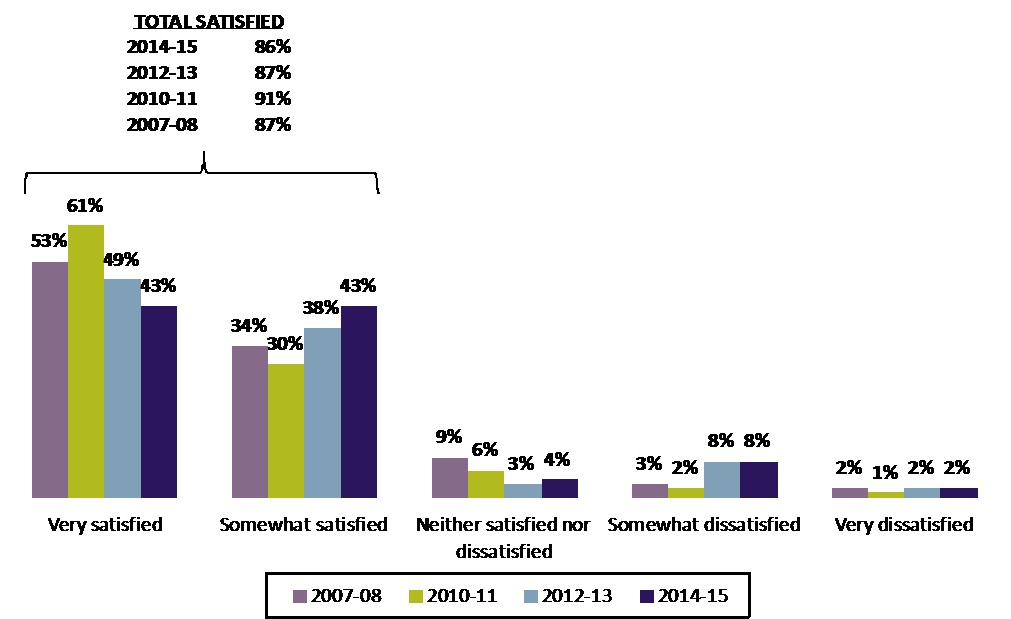
BASE: Total sample, excluding those with no opinion (2014-15 n=106)
Q1 Overall how satisfied are you with OSFI as the principal prudential regulator and supervisor of Canada's financial services industry?
The decline in the proportion who are "very satisfied" is more prominent among insurance companies (37% down from 45% in 2012-2013). While the difference in satisfaction levels between DTIs and insurance companies is not statistically significant, the trend over the last three waves indicates that the proportion of insurance companies that are "very satisfied" is declining.
Graph 2: Overall satisfaction with OSFI – Comparison between DTIs and Insurance Companies over time
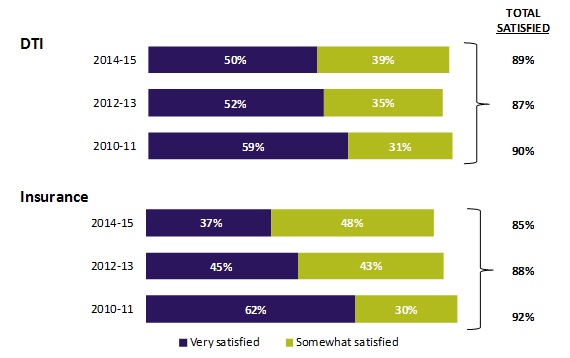
BASE: Total sample, excluding those with no opinion (DTI n=54; Insurance n=52)
Q1 Overall how satisfied are you with OSFI as the principal prudential regulator and supervisor of Canada's financial services industry?
Those who are very satisfied with OSFI (43% of total sample) say they appreciate that OSFI is a strong prudential regulator (29%), how approachable and responsive it is (29%), the knowledge and professionalism of its staff (29%), and that it promotes good communication and open dialogue (26%).
Graph 3: Reasons why very satisfied with OSFI* (unprompted comments among those who are "very satisfied")

BASE: Those who are very satisfied with OSFI, excluding those with no opinion (n=42). The sample size is too small to report DTI and insurance separately.
Note: Excludes n=4 responses of “don't know/no answer”
*Note: This is a new question added in 2014-15, thus no trend data is available.
Q1b What are the main reasons why you are very satisfied with OSFI?
The top concerns of those who are less than fully satisfied with OSFI is a perceived "one size fits all" approach (33%) and excessive regulatory burden and pace of change (33%). While reasons for not being fully satisfied with OSFI are mostly similar for DTIs and insurance companies, DTIs are more likely to say that OSFI is too rules-based or prescriptive (17%) while insurance companies are more likely to be concerned that OSFI does not take the Canadian context into account when considering international practices (20%).
Graph 4: Reasons why not more satisfied with OSFI* (unprompted comments among those who were not "very satisfied") Comparison between DTIs and Insurance Companies
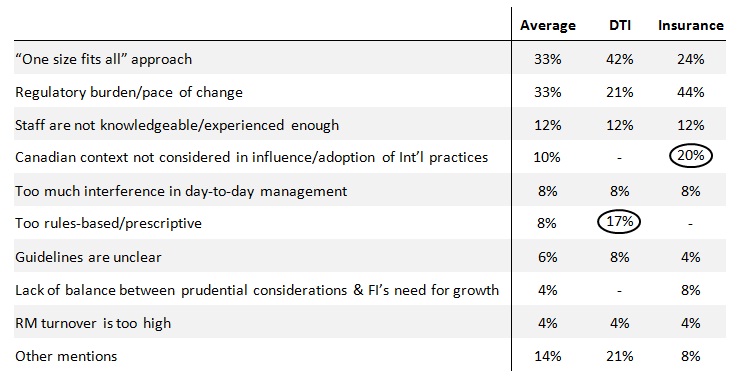
BASE: Those who are not "very satisfied" with OSFI (Total n=49; DTI n=24; Insurance n=25)
Note: Excludes n=11 responses of "don't know/no answer"
Note: This is a new question added in 2014-15, thus no trend data is available.
Q1c What are the main reasons why you are not more satisfied with OSFI?
Most respondents believe that OSFI focuses on the appropriate areas of risk in their sector (84% good). Positive views about how well OSFI focuses on the appropriate areas of risk in their sector are similar for both DTIs and insurance companies.
Graph 5 - Extent to which OSFI focuses on appropriate areas of risk* – Comparison between DTIs and Insurance Companies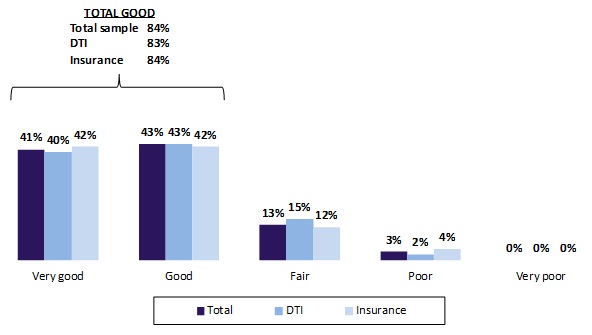
BASE: Total sample, excluding those with no opinion (2014-15 n=105, DTI n=53, Insurance n=52)
*Note: This is a new question added in 2014-15, thus no trend data is available.
Q2 How would you rate OSFI on the extent to which it focuses on the appropriate areas of risk in the (insurance/deposit-taking) sector?
There is no consensus among DTIs and insurance companies about the risk areas that OSFI should focus on in the next couple of years.
There is greater focus on consumer lending risk (19%), liquidity risk (15%), risk strategies appropriate to institution size (15%) and mortgage-related risk (11%) among DTIs, and on environmental risks (14%) and regulatory burden (7%) among insurance companies.
Graph 6 - Risk areas that should be priorities for OSFI (unprompted comments) – Comparison between DTIs and Insurance Companies
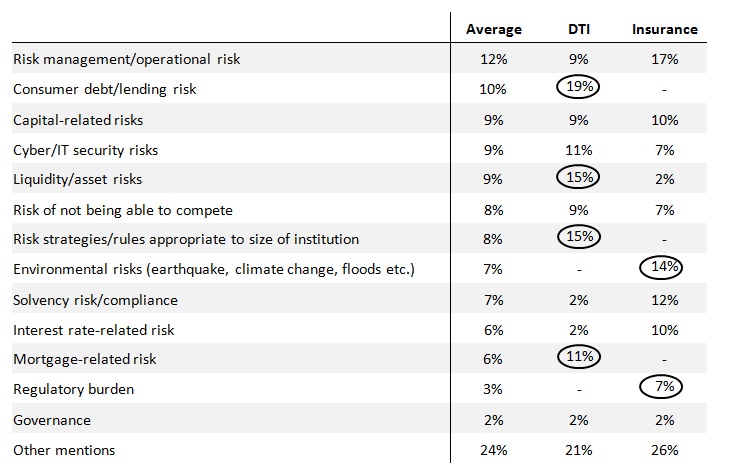
BASE: Total sample, excluding those with no opinion (Total sample n=89; DTI n=47; Insurance n=42)
Q3 What one or two risk areas do you believe should be priorities for OSFI in the next couple of years pertaining to [companies in the insurance sector / institutions in the deposit-taking sector]?
OSFI continues to receive overall positive ratings for consulting with industry when developing guidance (79% total good). The proportion who say OSFI is doing a very good job in this area has increased significantly since 2012-2013 (up 17 points to 39%).
Graph 7 - Rating of OSFI's performance on "consulting with the industry when developing guidance" over time

BASE: Total sample, excluding those with no opinion (2014-15 n=101)
Q5 How would you rate OSFI with respect to consulting with the financial services industry when developing guidance?
The overall jump in the proportion who say OSFI does a very good job consulting with industry is due primarily to the significant increase in positive views among insurance companies (42% very good, up 25 points since 2012-13). There is no statistically significant difference in views between DTIs (74% total good) and insurance companies (82% total good).
Graph 8 - Rating of OSFI's performance on "consulting with the industry when developing guidance" – Comparison between DTIs and Insurance Companies over time
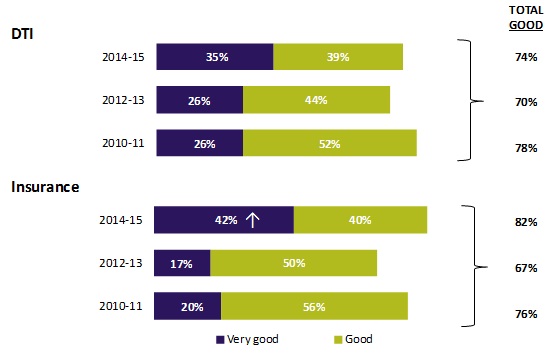
BASE: Total sample, excluding those with no opinion (DTI n=51; Insurance n=50)
Q5 How would you rate OSFI with respect to consulting with the financial services industry when developing guidance?
A majority (77% total good) give OSFI a positive rating for its timely response to market changes or industry suggestions that guidance needs updating. Although not statistically significant, this rating has improved since 2012-13 (69%).
Graph 9 - Rating of OSFI's performance on "responding in a timely manner to market changes/industry suggestions that guidance needs updating" over time

BASE: Total sample, excluding those with no opinion (2014-15 n=103)
Q4 How would you rate OSFI with respect to responding in a timely manner to market changes or to industry suggestions that guidance needs updating?
DTIs and insurance companies give OSFI similar ratings for its timely response to market changes or industry suggestions that guidance needs updating.
The slight increase in this measure is primarily due to insurance companies, who are now significantly more likely than in 2012-13 to say OSFI is doing a good or very good job in this area (79%, up 19 points).
While insurance companies were previously more negative about OSFI's performance in this area, their views are now on par with those of DTIs (75%).
Graph 10 - Rating of OSFI's performance on "responding in a timely manner to market changes/industry suggestions that guidance needs updating" – Comparison between DTIs and Insurance Companies over time
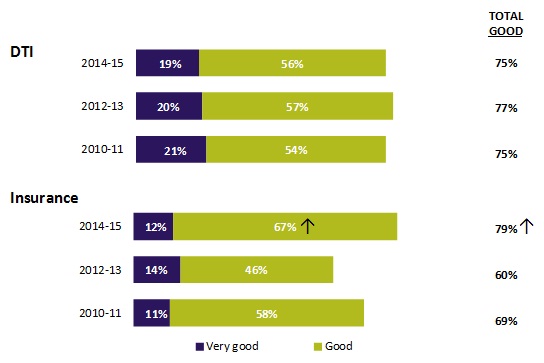
BASE: Total sample, excluding those with no opinion (Total sample n=103; DTI n=52; Insurance n=51))
Q4 How would you rate OSFI with respect to responding in a timely manner to market changes or to industry suggestions that guidance needs updating?
Six in ten (60%) give OSFI an overall positive rating for balancing prudential considerations and industry's need for competitiveness.
Overall positive ratings for OSFI on this measure have not changed significantly since 2012-13 but are moving in a positive direction (60% up from 53% 2012-2013).
Graph 11 - Rating of OSFI's performance on "striking an appropriate balance between prudential considerations and need for institutions to compete" over time
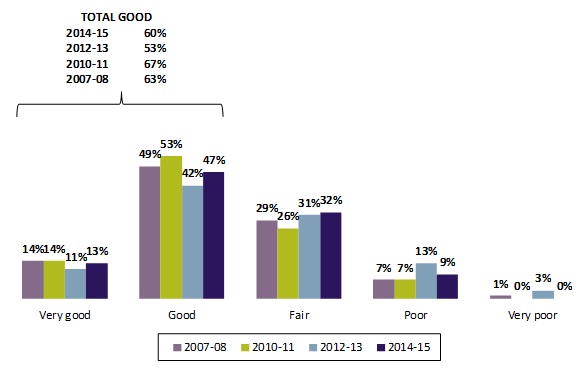
BASE: Total sample, excluding those with no opinion (2014-15 n=103)
Q10 How would you rate OSFI with respect to developing guidance that strikes an appropriate balance between prudential considerations and the need for institutions to compete?
Overall ratings for OSFI on balancing prudential considerations and competitiveness in its guidance remain within the historic range for both DTIs and insurance companies (62% DTI and 57% Insurance).
Graph 12 - Rating of OSFI's performance on "striking an appropriate balance between prudential considerations and need for institutions to compete" – Comparison for DTIs and Insurance Companies over time
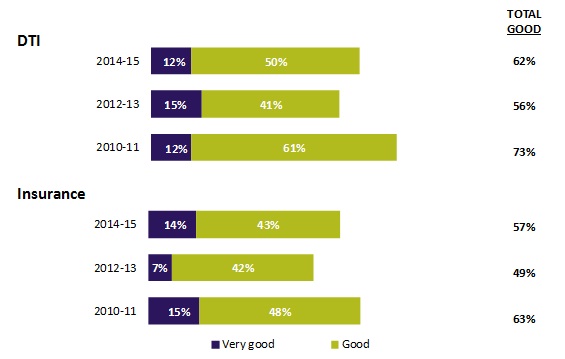
BASE: Total sample, excluding those with no opinion (DTI n=52; Insurance n=51)
Q10 How would you rate OSFI with respect to developing guidance that strikes an appropriate balance between prudential considerations and the need for institutions to compete?
Most believe OSFI's guidance is at least somewhat effective (85%) in providing a clear indication of its expectations, although only one in four (24%) say it is very effective in this area.
A split sample approach was used to test two different wordings for this question. Respondents were either asked about the effectiveness of OSFI's guidance in providing an "indication" (historical wording) or "a clear indication" (new wording) of its expectations.
While the total ‘effective' score is similar for the two alternatives, institutions are more likely to agree that OSFI's guidance is "very effective" at providing "an indication" (38%) of its expectations than at providing "a clear indication" (24%).
Graph 13 – Rating on perceived effectiveness of OSFI's guidance in providing a clear indication of its expectations
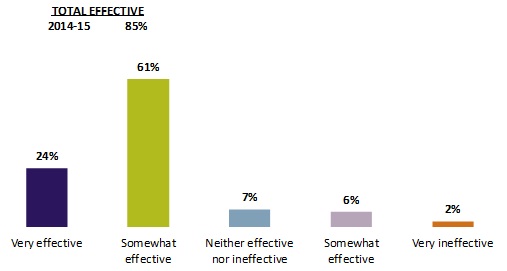
BASE: Total sample, excluding those with no opinion (n=54). Note that the sample size is too small to report DTI and insurance separately.
Q12 (ASKED OF ½ SAMPLE) Overall, how effective do you think OSFI's guidance is in providing a clear indication of its expectations?
Four in ten (40%) institutions indicated that they had submitted an application to OSFI in the past two years. This does not differ between DTIs and insurance companies.
A majority (78%) of institutions who have submitted applications are satisfied with OSFI in this area.
Graph 14 - Overall satisfaction with OSFI in processing applications – among applicants*

*BASE 2014-15: Have submitted an application to OSFI (n=42)
Note that these results cannot be compared to previous years because the question is now asked only of applicants
Q20 What is your overall level of satisfaction with OSFI in processing applications from your company/institution?
More than eight in ten (88%) say they understand somewhat well or very well the basis on which OSFI makes decisions about their applications for approval.
Graph 15 - Understanding of the basis on which OSFI makes applications decisions - among applicants*
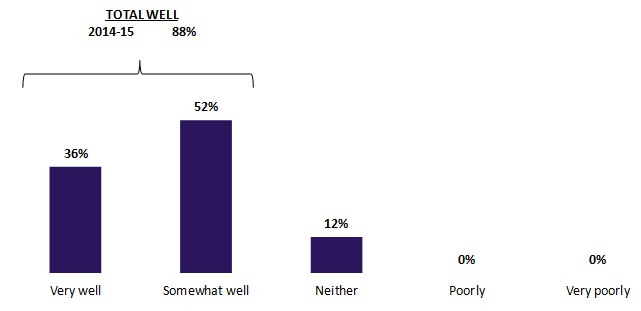
*BASE 2014-15: Have submitted an application to OSFI (n=42)
Note that these results cannot be compared to previous years because the question is now asked only of applicants
Q21 How well do you understand the basis on which OSFI makes decisions about your company/institution's applications?
More than eight in ten (84%) give OSFI overall positive ratings for providing an opportunity for discussion, consistent with previous waves (80% 2012-2013).
Graph 16 - Rating of OSFI's performance on "providing an opportunity to discuss issues of concern prior to OSFI coming to a conclusion" over time
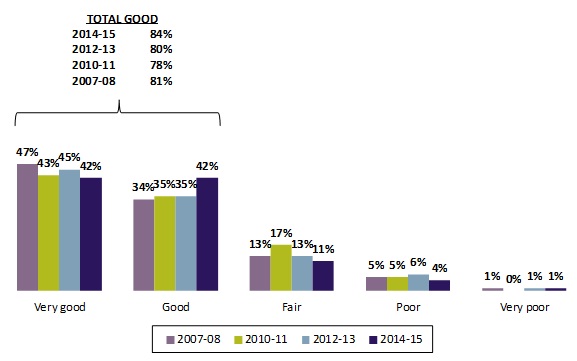
BASE: Total sample, excluding those with no opinion (2014-15 n=105)
Q13 How would you rate OSFI with respect to providing an opportunity for your company/institution to discuss issues of concern with OSFI prior to OSFI coming to a conclusion?
Similar to previous waves, more than eight in ten (83%) also give an overall positive rating for the clarity of OSFI's written correspondence (84% 2012-2013).
Graph 17 - Rating of OSFI's performance on "clarity of OSFI's written correspondence outlining issues of concern" over time

BASE: Total sample, excluding those with no opinion (2014-15 n=105)
Q14 How would you rate OSFI with respect to the clarity of OSFI's written correspondence (e.g., Management Reports and Supervisory Letters) outlining issues of concern?
A majority (78%) give OSFI an overall positive rating for the consistency between its written and oral communications, which is on par with previous waves (80% 2012-2013).
Graph 18 - Rating of OSFI's performance on "the consistency between OSFI's written and oral communications" over time
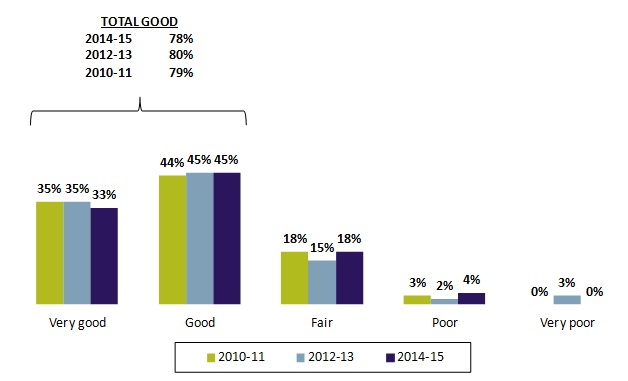
BASE: Total sample, excluding those with no opinion (2014-15 n=106)
Q15How would you rate OSFI with respect to the consistency between OSFI's written and oral communications?
Opinions about OSFI's performance on supervision-related activities are similar for both DTIs and insurance companies.
Graph 19 - Rating of OSFI's performance on supervision-related activities – Comparison between DTIs and Insurance Companies

BASE: Total sample, excluding those with no opinion
Q13-15 The following questions pertain to OSFI's supervision as it relates to your [company/institution]. How would you rate OSFI with respect to…?
As before, a large majority (89%) believe OSFI is effective in supervising their company or institution.
Graph 20 - Perceived effectiveness of OSFI's performance in "supervising your company/institution" over time
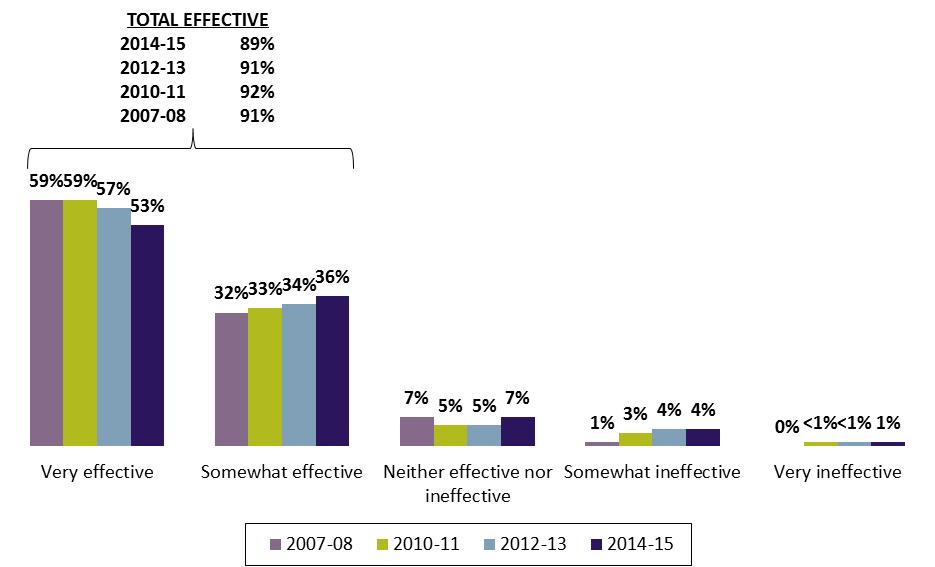
BASE: Total sample, excluding those with no opinion (2014-15 n=106)
Q18 Overall, how effective do you think OSFI is in supervising(i.e. ongoing monitoring, on-site reviews including supervisory recommendations, reporting requirements, etc.) your company/institution?
Almost all (97%) participating institutions are satisfied with OSFI staff's ability to communicate with the institution in its official language of choice, including nine in ten (89%) who are very satisfied. This remains consistent with previous waves (97% 2012-2013).
Graph 21 - Satisfaction with OSFI staff's ability to interact with financial institutions in their official language of choice (English or French) over time
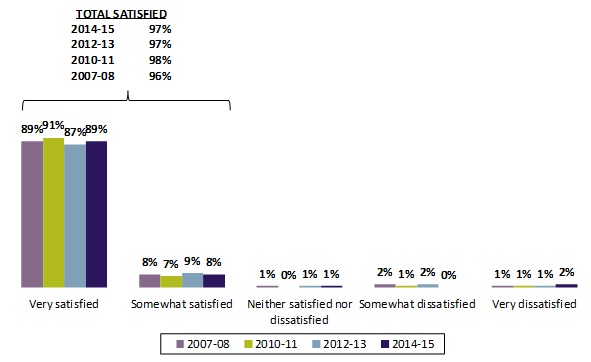
BASE: Total sample, excluding those with no opinion (2014-15 n=102).
Note: Two surveys were completed in French, all others in English.
Q26 Thinking about your dealings with OSFI staff on any supervisory or regulator matter, how satisfied are you with OSFI's capacity to interact with you in the official language of your choice (i.e., English or French)?
This section presents the results of a new subset of questions introduced in the 2014-15 FIS for small and mid-sized institutions as a result of new initiatives underway at OSFI focusing on issues specific to this segment. For the purposes of this study, small and mid-sized institutions are defined as all financial institutions excluding Canada's six largest banks and three largest life insurance companies.
Small and mid-size institutions give OSFI an overall positive rating for guidance-related activities. However they are most positive about OSFI providing the opportunity to comment (45% very good) compared to views about the transparency of the process (25% very good) or OSFI communicating its response once feedback has been provided (21%).
Graph 22 - Ratings of OSFI's performance on guidance-related activities* Small and mid-sized institutions only

BASE: Small and mid-sized institutions, excluding those with no opinion
*Note: These are new questions added in 2014-15, thus no trend data is available.
Q6-8 As needed, OSFI develops Guidance (which may include guidelines and advisories) for [companies in the insurance sector/institutions in the deposit-taking sector]. How would you rate OSFI with respect to…?
Opinions among small and mid-sized institutions about OSFI's guidance are similar for both DTIs and insurance companies.
Graph 23 - Ratings of OSFI's performance on guidance-related activities Small and mid-sized institutions only – Comparison between DTIs and Insurance Companies
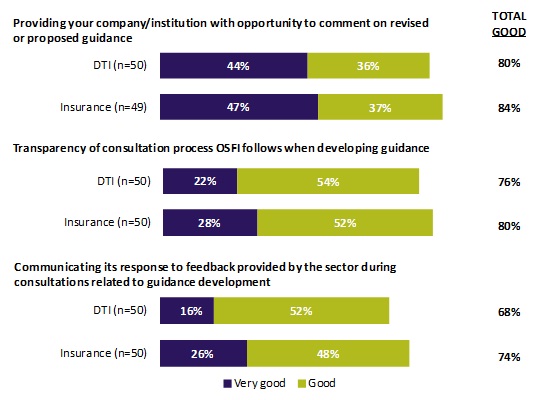
BASE: Small and mid-sized institutions, excluding those with no opinion
Q6-8 As needed, OSFI develops Guidance (which may include guidelines and advisories) for [companies in the insurance sector/institutions in the deposit-taking sector]. How would you rate OSFI with respect to…?
When asked for suggestions for improving the consultation process, small and mid-sized institutions would most like to see more consultation (25%) – a view that skews towards DTIs (39% vs. 8% of insurance companies) – but also greater transparency in terms of the overall process (23%) and how a decision is reached (21%).
Graph 24 - Suggestions for improving consultation process on guidance* (unprompted comments) Small and mid-sized institutions only – Comparison between DTIs and Insurance Companies
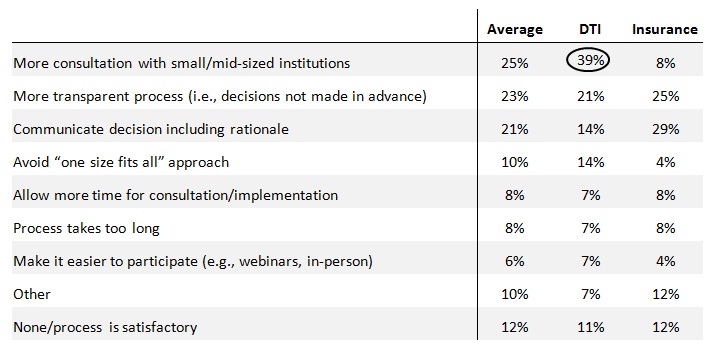
BASE: Small and mid-sized institutions (Total sample n=52; DTI n=28; Insurance n=24)
Note: Excludes n=52 responses of "don't know/no answer"
*Note: This is a new question added in 2014-15, thus no trend data is available.
Q9 Do you have any suggestions for improving the consultation process OSFI follows when developing guidance?
Ratings of how good a job OSFI does at conveying the scalability of its guidance are lower than other survey results (43% total good).
While not statistically significant, insurance companies are somewhat more positive than DTIs on this measure (49% total good insurance vs. 38% total good DTI).
Graph 25 - Rating of OSFI's performance on "conveying that guidance may be scaled to reflect nature, size and complexity of your company/institution"* – Small and mid-sized institutions only – Comparison between DTIs and Insurance Companies
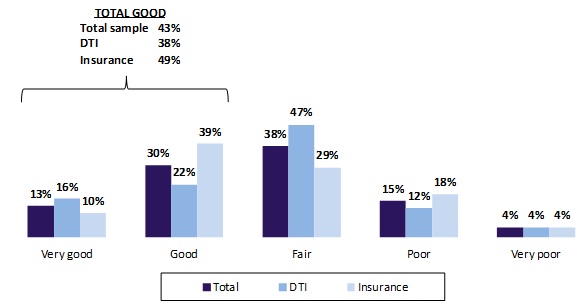
BASE: Small and mid-sized institutions, excluding those with no opinion (Total sample n=100; DTI n=51; Insurance n=49)
*Note: This is a new question added in 2014-15, thus no trend data is available.
Q11 How would you rate OSFI's guidance on the extent to which it conveys that the guidance may be scaled to reflect the nature, size and complexity of your company/institution?
Small and mid-sized institutions hold moderately more positive views about the extent to which OSFI scales its supervision (63%) and the application of its guidance (54%) taking into account the nature, size and complexity of the institution.
Graph 26 - Ratings of OSFI's performance on scaling its supervision and guidance* – among small and mid-sized institutions only
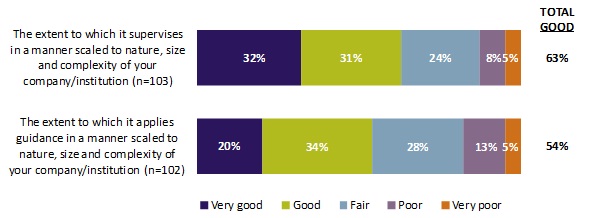
BASE: Small and mid-sized institutions, excluding those with no opinion
*Note: These are new questions added in 2014-15, thus no trend data is available.
Q16-17 The following questions pertain to OSFI's supervision as it relates to your [company/institution]. How would you rate OSFI with respect to…?
Small and mid-sized insurance companies are more positive than DTIs on the extent to which OSFI scales its supervision (70% total good insurance vs. 56% DTIs) and applies guidance (62% total good insurance vs. 46% DTIs) in a manner scaled to reflect the nature, size and complexity of institutions. The proportion of insurance companies who say OSFI is doing a very good job in these areas accounts for the higher ratings from that sector.
Graph 27 - Rating of OSFI's performance on scaling its supervision and guidance Small and mid-sized institutions only – Comparison of results between DTIs and Insurance Companies

BASE: Small and mid-sized institutions, excluding those with no opinion
Q16-17 The following questions pertain to OSFI's supervision as it relates to your [company/institution]. How would you rate OSFI with respect to…?
More than six in ten (63%) small and mid-sized DTIs are aware of the recently created Advisor role at OSFI; almost two-fifths (37%) are not aware.
Graph 28 - Awareness of "Small and Mid-sized Advisor" role* – DTIs only
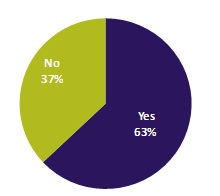
BASE: Small and mid-sized DTIs, excluding those with no opinion
*Note: This is a new question added in 2014-15, thus no trend data is available.
Q23 As announced in the Government of Canada's 2014 budget, OSFI has appointed an Advisor who will engage industry representatives as well as OSFI employees to help address some of the challenges faced by small and mid-sized deposit-taking institutions, where feasible. Were you aware that a "Small and Mid-Sized Advisor" role was recently created at OSFI? (n=52)
Among those aware of the "Small and Mid-Sized Advisor" role, more than six in ten (63%) give OSFI moderately positive ratings for how well it has communicated the role's objectives. Another one in five (22%) are neutral, while a small proportion (16%) say it has been poorly communicated.
Graph 29 - How well OSFI has communicated objectives of "Small and Mid-sized Advisor" role* – Only DTIs aware of the creation of role
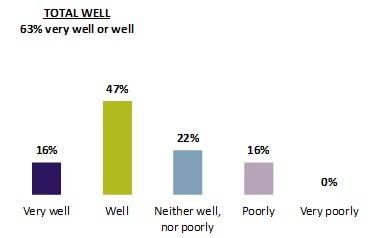
Q24 (IF AWARE) How well has OSFI communicated the objectives of the "Small and Mid-Sized Advisor"? (n=32)
*Note: This is a new question added in 2014-15, thus no trend data is available
The top priority issues recommended by small and mid-sized institutions is scaling expectations to the size and complexity of the business (49%) followed by reducing the regulatory burden/pace of change (24%) and capital requirements suitable for small and mid-size institutions (14%).
The priorities mentioned by DTIs and insurance companies are largely similar. Priorities raised only by DTIs include greater consideration of the differences in parent-branch or subsidiary relationships (13%) and balancing prudential considerations with financial institutions' need to compete in the marketplace (10%). Some insurance companies also mentioned ORSA as a priority (20%).
Graph 30 - Issues pertaining to small and mid-sized institutions that OSFI should prioritize in the next year* (unprompted comments among small and mid-sized institutions) – Comparison between DTIs and Insurance Companies
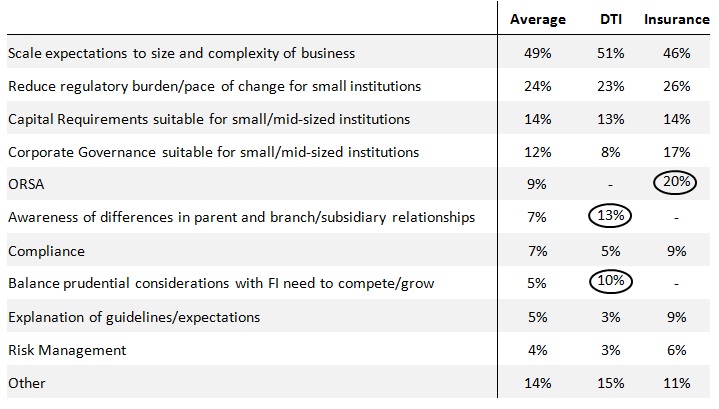
BASE: Small and mid-sized institutions (Total sample n=74; DTI n =39; Insurance n=35)
Note: Excludes n=29 responses of "don't know/no answer"
*Note: This is a new question added in 2014-15, thus no trend data is available.
Q25 What one or two issues pertaining to small and mid-sized [insurance companies/deposit-taking institutions] do you believe OSFI should make priorities in the next year?
Most give OSFI an overall positive rating (79%) for being proactive on emerging issues and this is essentially unchanged from previous waves (79% 2012-2013).
Graph 31 - Impressions of how proactive OSFI is in dealing with emerging issues pertaining to their sector over time

BASE: Total sample, excluding those with no opinion (2014-15 n=103)
Q22 How would you rate OSFI with respect to how proactive it is in dealing with emerging issues pertaining to the [insurance/deposit-taking] sector?
DTIs and insurance companies give OSFI similar ratings for being proactive on emerging issues and have not changed significantly from previous waves.
Graph 32 - Impressions of how proactive OSFI is in dealing with emerging issues pertaining to their sector – Comparison between DTIs and Insurance Companies over time

BASE: Total sample, excluding those with no opinion (Total sample n=103; DTI n=52; Insurance n=51)
Q22 How would you rate OSFI with respect to how proactive it is in dealing with emerging issues pertaining to the [insurance/deposit-taking] sector?
Relatively few institutions provided additional comments about issues raised in the survey. Final comments received echo the themes seen in other lines of questioning such as scaling regulations to size and complexity of institutions, continuing to focus on small mid-size institutions and continued awareness of regulatory burden.
Graph 33 - Final comments (unprompted comments)

BASE: Total sample, excluding those with no opinion (n=19)
Note: Excludes n=87 responses of "don't know/no opinion"
Q28 Are there any other comments you would like to make concerning the issues raised in this questionnaire?
September 22, 2014
To: Federally Regulated Financial Institutions
Subject: Confidential on-line survey commissioned by OSFI
I am writing to invite your participation in an important confidential on-line survey that is being conducted by Environics Research Group on behalf of the Office of the Superintendent of Financial Institutions (OSFI). Since 1998, OSFI has commissioned consultations with senior members of the financial community to obtain their assessment of OSFI's effectiveness as a regulator and supervisor. Your participation in the survey is voluntary. Your acceptance or refusal to participate will not affect your relationship with OSFI, however, the results will help OSFI to improve our performance, which we believe is of ultimate benefit to you and your organization.
In the accompanying e-mail, you will find a link to the survey, which is hosted on a secure Internet site. Only Environics will have access to your electronic responses. The survey should take approximately 15 minutes to complete and you may pause and save your responses at any time. Feel free to canvass your colleagues for their views, if you feel this would be helpful.
OSFI is committed to a confidential consultation process and the resulting report will present responses in summary form and without attribution. As part of OSFI's commitment to transparency and accountability, the final results will be posted on OSFI's website in spring 2015.
If you would like to discuss this consultation, please feel free to contact Laura Buckland, Manager of OSFI Consultations, at (613) 990-9959, or Sarah Roberton, Senior Research Associate, Environics at 613-230-5089.
We hope we can count on your participation.
Sincerely,
Jeremy Rudin,
Superintendent
Environics Research Group has been retained by the Office of the Superintendent of Financial Institutions (OSFI) to conduct the 2014 edition of its biennial survey with Chief Executive Officers of Federally Regulated Financial Institutions.
You are invited to provide your assessment of OSFI's effectiveness as a supervisor and regulator. Your feedback is critical for OSFI to understand how well it is achieving its strategic objectives, in order to be accountable to stakeholders like yourself and to improve its effectiveness. Participation in the survey is voluntary and will take about 15 minutes.
You can be assured that Environics, as an independent third party, will hold your comments in strict confidence. OSFI will not know who participated in the research or what specific institutions/companies have said about it.
As a standard industry practice, Environics has put in place secure procedures to ensure that confidentiality is maintained at all times. The survey is registered with the Market Research and Intelligence Association. Click here [POP-UP IN NEW BROWSER WINDOW] if you wish to verify its authenticity.
Environics will provide OSFI with a report aggregating the findings from this survey. The results of the research will be posted on OSFI's web site.
To begin the survey, please click on the [>>] button below.
Please only use the [<<] or [>>] buttons to navigate through the survey.
1. Overall, how satisfied are you with OSFI as the principal prudential regulator and supervisor of Canada's financial services industry?
[If Q1=99, Skip to Q2]
b) [If Q1=5] What are the main reasons why you are very satisfied with OSFI?
c) [If Q1=1-4] What are the main reasons why you are not more satisfied with OSFI?
2. How would you rate OSFI on the extent to which it focuses on the appropriate areas of risk in the (insurance/deposit-taking) sector?
3. What one or two risk areas do you believe should be priorities for OSFI in the next couple of years pertaining to (companies in the insurance sector/institutions in the deposit-taking sector)?
As needed, OSFI develops Guidance (which may include guidelines and advisories) for (companies in the insurance sector/institutions in the deposit-taking sector).
How would you rate OSFI with respect to:
4. Responding in a timely manner to market changes or to industry suggestions that guidance need updating
5. Consulting with the financial services industry when developing guidance
6. [Programming instruction: Only ask of small and mid-sized Institutions ] Providing your (company/institution) with the opportunity to comment on revised or proposed guidance
7. [Programming instruction: Only ask of small and mid-sized Institutions ] The transparency of the consultation process OSFI follows when developing guidance (e.g., the means by which industry members may provide feedback, the timing for feedback, the timing of OSFI's response)
8. [Programming instruction: Only ask of small and mid-sized Institutions ] Communicating its response to feedback provided by the sector during consultations related to guidance development
9. [Programming instruction: Only ask of small and mid-sized Institutions ] Do you have any suggestions for improving the consultation process OSFI follows when developing guidance?
10. How would you rate OSFI with respect to developing guidance that strikes an appropriate balance between prudential considerations and the need for institutions to compete?
11. [Programming instruction: Only ask of small and mid-sized Institutions ] How would you rate OSFI's guidance on the extent to which it conveys that the guidance may be scaled to reflect the nature, size and complexity of your (company / institution)?
12. (ASK OF RANDOM ½ SAMPLE) Overall, how effective do you think OSFI's guidance is in providing a clear indication of its expectations?
(ASK OF RANDOM ½ SAMPLE) Overall, how effective do you think OSFI's guidance is in providing an indication of its expectations?
b) [If Q12=1-2] What are the key reasons why you say OSFI's guidance is ineffective in providing [PIPE IN “a clear” IF SPLIT SAMPLE IS 1ST and “an” if SPLIT SAMPLE IS 2ND ] indication of its expectations?
The following questions pertain to OSFI's supervision as it relates to your (company / institution).
How would you rate OSFI with respect to:
13. Providing an opportunity for your (company/institution) to discuss issues of concern with OSFI prior to OSFI coming to a conclusion
14. The clarity of OSFI's written correspondence(e.g., Management Reports and Supervisory Letters) outlining issues of concern
15. The consistency between OSFI's written and oral communications
16. [Programming instruction: Only ask of small and mid-sized Institutions ] The extent to which it supervises (e.g., ongoing monitoring, on-site reviews including supervisory recommendations, reporting requirements, etc.) in a manner that is scaled to reflect the nature, size and complexity of your (company/institution).
17. [Programming instruction: Only ask of small and mid-sized Institutions ] The extent to which it applies guidance in a manner that is scaled to reflect the nature, size and complexity of your (company/institution).
18. A. (ASK OF 1st RANDOM ½ SAMPLE) Overall, how effective do you think OSFI is in supervising (e.g. ongoing monitoring, on-site reviews including supervisory recommendations, reporting requirements, etc.) your (company/institution)?
18 B. (ASK OF 2nd RANDOM ½ SAMPLE) Overall, how effective do you think OSFI is in monitoring and supervising your (company/institution)?
19. As you know, OSFI's Superintendent, and in some cases the Minister of Finance, must approve certain initiatives (companies in the insurance sector/institutions in the deposit-taking sector) wish to take. The following questions pertain to OSFI's approvals process as it relates to your (company/institution).
Have you submitted an application to OSFI on behalf of your (company/institution) in the last two years?
20. What is your overall level of satisfaction with OSFI in processing applications from your (company/institution)?
21. How well do you understand the basis on which OSFI makes decisions about your (company's/institution's) applications?
22. How would you rate OSFI with respect to how proactive it is in dealing with emerging issues pertaining to the (insurance / deposit-taking) sector?
23. [Programming instruction: Only asked of small and mid-sized DTI's] As announced in the Government of Canada's 2014 budget, OSFI has appointed an Advisor who will engage industry representatives as well as OSFI employees to help address some of the challenges faced by small and mid-sized deposit-taking institutions, where feasible.
Were you aware that a “Small and Mid-Sized Advisor” role was recently created at OSFI?
24. [Programming instruction: Only asked of small and mid-sized DTI's][If Q23=Yes] How well has OSFI communicated the objectives of the “Small and Mid-sized Advisor”?
25. [Programming instruction: Only ask of small and mid-sized Institutions ] What one or two issues pertaining to small and mid-sized (insurance companies / deposit-taking institutions) do you believe OSFI should make priorities in the next year?
26. Thinking about your dealings with OSFI's staff on any supervisory or regulatory matter, how satisfied are you with OSFI's capacity to interact with you in the official language of your choice (i.e., English or French)?
27. [If Q26=1-2] Which of the following are areas in which you are dissatisfied? (SELECT ALL THAT APPLY)
Are there any other comments you would like to make concerning the issues raised in this questionnaire?
Subject line: Reminder: OSFI's Financial Institutions Survey
This is a reminder concerning OSFI's financial institutions survey. You will have recently received a letter from Jeremy Rudin, Superintendent of OSFI, requesting your participation. If you have not received the letter, please contact us and we will share a copy with you.
The financial institutions survey is being conducted online. The link below will take you to the secure Internet site provided by Environics Research Group, the independent consulting firm that OSFI has commissioned to undertake the research, where you can complete the survey.
If you have already completed the survey, we thank you for your participation and kindly request that you disregard this reminder.
To maintain confidentiality, this invitation was sent to you by Environics.
INSERT LINK
If you would like to discuss this matter at any time during the process, please contact me at (613) 230-5089 (ext. 224) (sarah.roberton@environics.ca), or Laura Buckland, Manager of Consultations, OSFI at (613) 990-9959 (laura.buckland@osfi-bsif.gc.ca).
Sincerely,
Sarah Roberton
Senior Research Associate
Environics Research Group
Tel: (613) 230-5089 (ext. 224)
www.environics.ca
Subject line: Reminder: OSFI's Financial Institutions Survey closes on October 17
This is a reminder concerning OSFI's financial institutions survey – the survey will be closing on Friday, October 17th.
Your participation in the survey is voluntary and anonymous. Your acceptance or refusal to participate will not affect your relationship with OSFI, however, the results will help OSFI to improve its performance, which we believe is of ultimate benefit to you and your organization.
The link below will take you to the secure Internet site provided by Environics Research Group, the independent consulting firm that OSFI has commissioned to undertake the research, where you can complete the survey.
INSERT LINK
If you would like to discuss this matter at any time during the process, please contact me at (613) 230-5089 (ext. 224), or Laura Buckland, Manager of Consultations, OSFI at (613) 990-9959 (laura.buckland@osfi-bsif.gc.ca).
Sincerely,
Sarah Roberton
Senior Research Associate
Environics Research Group
Tel: (613) 230-5089 (ext. 224)
www.environics.ca
Subject line: OSFI's Financial Institutions Survey - Deadline extended to October 22
The deadline for OSFI's survey has been extended to Wednesday, October 22 at midnight. The survey will take only 10-15 minutes of your time.
OSFI values your feedback. While participation is voluntary, the results of this survey will help OSFI to improve its performance as a regulator and supervisor.
Environics Research Group has been commissioned to conduct this research. Please be assured that all answers you share with us will remain strictly confidential and anonymous.
Please click on the link below to participate in the survey:
INSERT LINK
If you have questions, please contact me at (613) 230-5089 (ext.224) (sarah.roberton@environics.ca) or Laura Buckland, Manager of Consultations, OSFI at (613) 990-9959 (laura.buckland@osfi-bsif.gc.ca).
Sincerely,
Sarah Roberton
Senior Research Associate
Environics Research Group
www.environics.ca